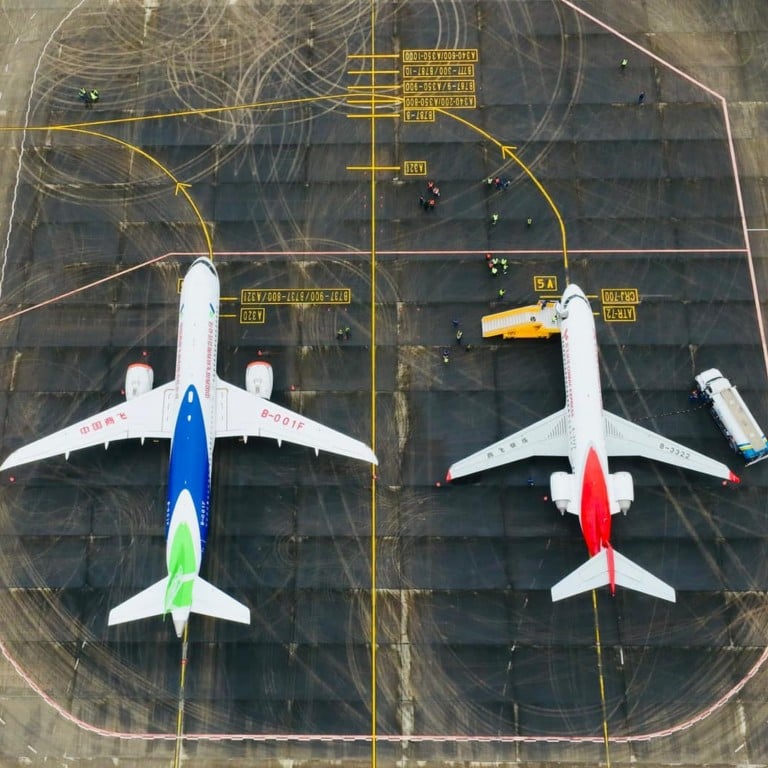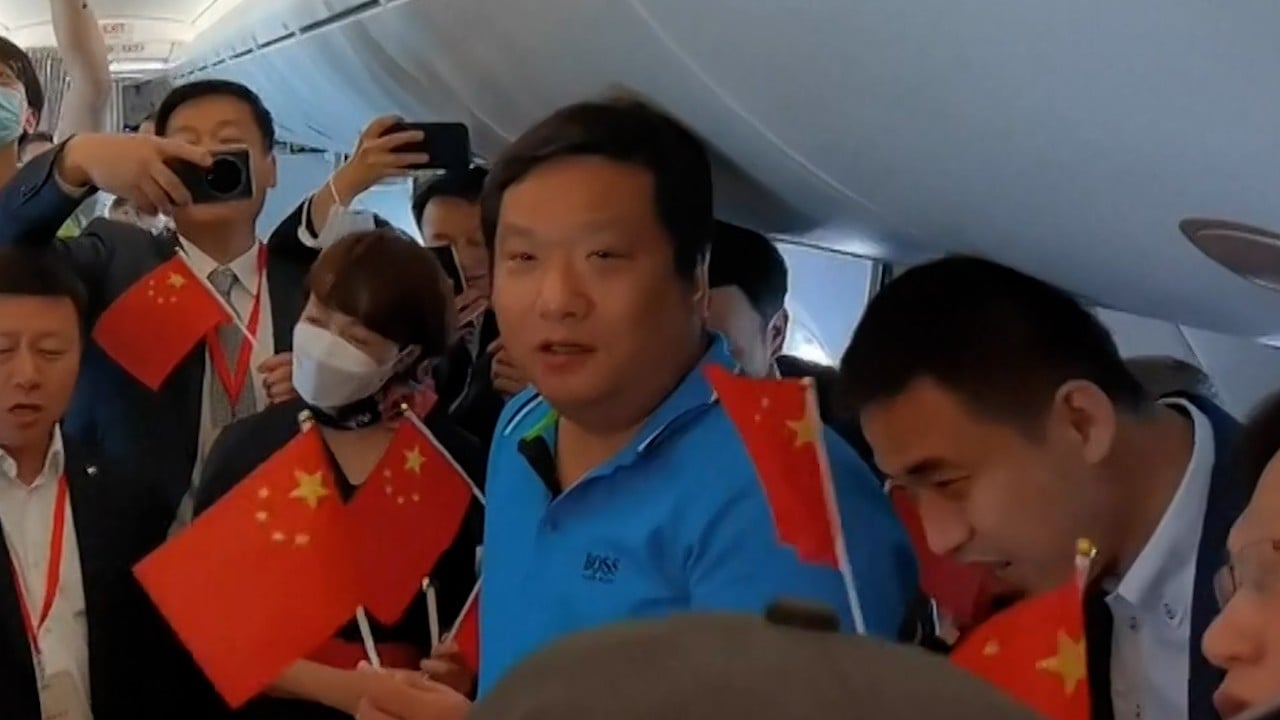
How China’s C919 jet reflects ambitions to skirt US restrictions and soar beyond global leaders
- With the Boeing-Airbus duopoly in its sights, the maker of China’s home-grown narrowbody plane is courting Southeast Asia. But what challenges must be overcome?
- C919 plays a key role in China’s pivot towards self-reliance and as it seeks to reduce imports of advanced technology amid intense geopolitical entanglements
Southeast Asia’s fast-growing aviation market looks to become a battleground for the maker of China’s home-grown C919 passenger jet – contending alongside the duopoly of Airbus and Boeing – as Chinese manufacturers bid to move up the global supply chain amid US restrictions.
Strong trade ties with China, and a still-rising post-Covid rebound in air travel that has resulted in new airlines and new routes, mean the region has become the No 1 target for the state-owned Commercial Aircraft Corporation of China (Comac) outside of its home market.
“There’s an untapped intra-Asian market within Southeast Asia that Comac can penetrate with the C919, even if it will be competing against very established jets such as the Airbus A320 and Boeing 737 Max,” said Shukor Yusof, founder of aviation advisory firm Endau Analytics.
China’s C919 maker has lofty ambitions to claim some Boeing, Airbus market share
Although the C919’s first appearance at the Singapore Airshow on February 20 generated a lot of fanfare, analysts said it was only the beginning, pointing out that Comac still needs to invest more in the ability to service its planes.
“Time and a wider range of aircraft offerings, in terms of size and use, and a widespread base of certified operational centres as well as comfortable regulators” are still needed for Comac to secure more orders for its planes, said Andrew Charlton, managing director of Aviation Advocacy. “This is not something for this decade.”
“It may create the greatest export opportunity for C919 in the medium and longer term.”
Demand for flights in Southeast Asia is expected to rise significantly, making a strong case for the Chinese aerospace manufacturer to build out its product range and services to appeal to carriers in the region.
Comac has predicted that, in the next two decades, the number of civilian passenger aircraft in the world will increase from 24,264 to 51,701, and in the Asia-Pacific market the number of commercial jets was seen increasing from 3,314 to 9,701.
Vietnam’s low-cost airline VietJet Air said late last year that it would open five new international routes to Taipei, Hong Kong, Busan, Adelaide and Perth. And Thailand expects to see launches of new carriers in the coming months.
How monumental is China’s challenge to build its own jet engine for the C919?
“As the country [Thailand] maintains recovery momentum, the growth in demand provides space for both existing airlines and start-up airlines,” said Scott Zhao, senior aviation Analyst at Cirium Ascend Consultancy.
Yusof at Endau Analytics said Comac’s C919 will appeal to some carriers, but pricing and maintenance, as well as support incentives, are critical considerations.
“There are thousands of islands in Southeast Asia, so perhaps the ARJ21 is more suitable for some airlines,” Yusof added.
Last year, Comac opened its first regional representative office in Indonesia, where its only customer in Southeast Asia, TransNusa, has been flying the ARJ21 from Jakarta to Malaysia’s capital, Kuala Lumpur.
The office in Jakarta is seen as an important step for the Chinese manufacturer to commit to providing aircraft maintenance, repair and overhaul – an area that it lacks experience, analysts said.
Desmond Goh, managing director for the Asia-Pacific region at Eaton Industries’ Aerospace Group, said that for the C919 and ARJ21 to be successful, Comac needs to be able to build a good support network and infrastructure around where it services.
“One of the key reasons that the Superjet [a regional jet designed by Russian company Sukhoi Civil Aircraft] never really took off was that it didn’t have a support network around the world,” Goh said during the China-Singapore Bilateral Aviation Forum at the Singapore Airshow on February 22.
“Even though they could sell the aircraft, they couldn’t support it. That’s why all the airlines and the customers struggled.”
Comac said in a statement regarding its Southeast Asia marketing tour that it is “committed to developing good products and providing good services” and that it strives to “provide a reliable new choice for the international civil aviation market”.
Charlton at Aviation Advocacy said Comac needs to produce a wider range of planes to broaden its appeal to carriers.
“Airlines, as a rule, do not like to add complications, which a new aircraft, from a new manufacturer, would add,” Charlton said.
The C919 also plays an important role in China’s pivot towards self-reliance and as it seeks to reduce imports of advanced technology amid intense competition with the US.
In aerospace, Washington has imposed export curbs on technology and products that it designates as having both military and commercial uses. Over the years, the US government has grown wary of Beijing’s civil-military fusion strategy, with politicians describing it as a national security threat.
Development of the narrowbody passenger jet, which has many key parts produced by foreign suppliers, has been touted by China as a demonstration of “win-win” cooperation through global collaboration.
China’s commercial jet aspirations overblown, US think tank finds
Beijing has spoken out against US restrictions on hi-tech exports, saying such moves produce no winners while also vowing to protect Chinese business interests.
Chinese aerospace manufacturers attending the Singapore Airshow have cited deteriorating China-US relations and trade tensions among the major problems facing their exports.
One Chinese aerospace exhibitor at the Airshow said the company had sought to avoid US tariffs imposed on Chinese exports by moving an assembly line to Vietnam.
“It turned out to be a very costly move for us,” said a sales manager who didn’t want to be named as he was not authorised to speak with the media.
“Vietnam doesn’t really have the necessary infrastructure that China has. Unless we are prepared to put in even more money to transfer what we have in China to Vietnam, such a move could be counterproductive.”
Jimmy Yeung, a director at King Pacific Plastics, which specialises in fabricating finished goods for many industries including aerospace, said many Chinese companies already have an edge in terms of pricing.
“I think it’s a fair competition,” Yeung said on the sidelines of the Singapore Airshow. “Whether they [Chinese companies] are able to come out on top – I think it may take a few decades.”
For now, tensions between Beijing and Washington do not appear to have affected China’s ambitions in producing a commercial passenger jet for export, having had success in other types of transport such as high-speed rail and electric vehicles.
China’s C919 spreads its wings in Singapore, international bow lands 40 orders
Liu Yuqiang, a senior executive with Shandong Stopart Brake Materials, which specialises in carbon-ceramic brake discs, discussed the importance of Chinese companies continuing to be a part of the global supply chain in aviation.
“The civil aviation industry is very much a globalised one,” Liu said on the sidelines of the air show. “It isn’t confined to a particular geography.
“The number of commercial jets operating in China has yet to reach 5,000. We should be part of a globalised market.”
Boeing and Airbus have said they welcome competition from Comac, and that the commercial passenger jet market is large enough to accommodate another player. Meanwhile, analysts have said it is just a matter of time – likely decades – before Comac can really chip away at the Airbus-Boeing duopoly.
It’s not if, but when Comac will mature this aircraft to then compete for a larger market share with Airbus and Boeing
Comac’s C919 and the ARJ21 have been certified by only the Civil Aviation Administration of China (CAAC). Both planes currently lack certifications from aviation regulators in the US and Europe.
Meanwhile, Comac is still able to operate its two key offerings away from where they will need certifications from the US Federal Aviation Administration (FAA) and European Union Aviation Safety Agency (EASA).
However, Alex Krutz, managing director at aerospace- and defence-focused consultancy Patriot Industrial Partners, based in the US, said an FAA certification remains essential if Comac intends to become a successful maker of commercial passenger jets.
“Look at both Airbus and Embraer. It took both … around three decades [to mature]. They both did this through the FAA certification process,” Krutz said. “It’s likely to take Comac the same amount of time, if not longer, to achieve this same level of maturity.
“I have said in the past – it’s not if, but when Comac will mature this aircraft [the C919] to then compete for a larger market share with Airbus and Boeing.”



